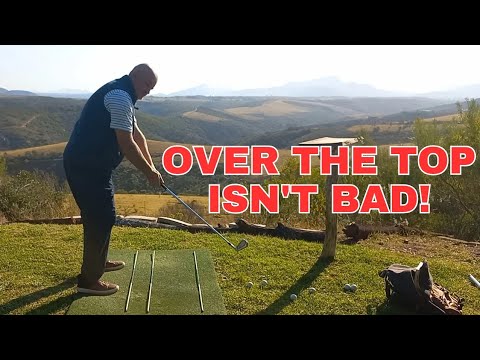In golf, the term “over the top” often carries a negative connotation, suggesting a flawed swing that leads to poor shots. However, in this video Owen presents a nuanced perspective. The concept revolves around the idea that while an over-the-top move can be detrimental, it is not inherently problematic if executed correctly. The key lies in ensuring that the clubhead remains inside the ball-to-target line during the downswing, even if the club’s path is slightly above the backswing path.
There’s nothing wrong with coming over the top. And I know what you must be thinking is what is he talking about? Because we’ve all heard that an over the top move is bad for the golf swing. And yes, it is bad if the club head gets onto the other side of your ball to target line. But if I take my back swing on this path and I bring the club back down over the top, in other words, above my back swing path, I can still keep that club head inside my ball to target line. So that’s what I mean. If you if you do get over the top, in other words, if your downswing path is a little bit above your back swing path, over the top, yet the club head is still on the inside of your ball to target line, you’re going to be okay. Now, it’s when the club head gets onto the other side of that ball to target line that all sorts of problems arise. Of course, we end up spinning a little bit out of it, the weight stays back. We get the hands high, we get that shaft vertical, makes it very difficult for us to to release um to get any kind of hand speed into the shot. What is the most common cause over the top? It’s when we’re in such a rush from the top to get the club head to the ball. We’re in such a rush that we just throw everything at it, including the kitchen sink. Golf, and I’m sure you’ve heard this, golf requires patience. It really does. It requires a lot of patience. Not only mentally being patient with your course oncore strategies, but even in the golf swing itself. And what I mean by that is we do need speed and we do want to generate power to hit the golf ball. Now the key is and this is where the patience comes into it is when you get to the top you got to be patient by letting the club free fall where it drops down a little bit more the inside. And once you’ve allowed that club to initially just drop and you get into this slot here, you can go as hard as you want at it. because you’ve dropped it into this position here. You have the sweet spot behind your tailbone. All right? And now you can go as hard as you want and do it with a body turn. Do it with a body rotation. Do it with a forearm rotation. Doesn’t matter. You can do it with both body and arms, forearm rotation. Because once you have set the club in this position on the way down, club head behind the hands, sweet spot behind the tail the the the tailbone, whichever way you want to think of it. Once you’re in this position here, it’s extremely difficult to hit it left. So that’s where the patience comes in because when we’re in a hurry, this just gets outside the line in an over the top way. It goes outside the ball to target line. There’s those big old ugly slices that have absolutely no power whatsoever. Sure, we can think about the club head staying on this line, but I often see what golfers tend to do is in attempting to bring bring the club head down on the inside, they start to rock back. They start to fall back. The weight starts to fall back onto the heels and the golfers start to early extend. I could get into the nitty-gritty and say you have to feel a shallowing in the shaft. You know, you got to feel a bowing in the wrist and all of that, but there’s a really easy way to do this. where it fixes the problem or the issue in your down swing without having to think too much about it. And of course, the down swing happens so quick. The best drills are the ones where we don’t have to think about it where kind of instinct takes over. I’ve got these three alignment sticks here. Okay, so there the ball to target line. I’m getting into my ready to hit position and take a look at where my hands are. My hands are in between these two sticks here. Okay? The one close to my feet and the one just sort of between my feet and the ball. You see how my hands are in that gap there. Now, what I would like to think of is on the way down is not allowing my hands to get onto the outside of this middle stick here, the middle alignment rod. We don’t want that. We want this. At the same time, I don’t want my hands to move this side of this alignment stick that’s close to my feet. Because if I’m rocking back to try and keep the club head approaching from the inside and I start rocking back, this becomes a problem. Here, you can see how the the the hands want to move on on this side of that. So, when you’re hitting, get to the top and start your down swing and get to a position where the shaft is horizontal to the ground. So, you get to top your back swing and you just drop it. Now, what I want you to do, like my chest, the zip on my jacket is looking at the camera. I would like my zip on the jacket to be facing the camera for longer. You see that? We don’t want we don’t want to throw the trail shoulder at the ball. So, I’m keeping the zip on my jacket, looking at the camera, dropping it here to where the club head is behind my tailbone. Shaft is horizontal to the ground. Okay. So, do this. Get to the top. Take like 5 seconds. Do it really slow. This is going to teach you patience as well. Get to the top. Go. One, four, five. Okay. Now from here it hit. So we know that the the hands will move inside. There’s no doubt about that. But when you’re bringing the club down, we want to keep them through impact. So, let’s say where the shaft’s horizontal to the ground impact shaft horizontal to the ground. Do your best to keep your hands between these two tram lines here. The hands move onto that side of the outside tram line. Club head’s going to get outside the ball to target line. And if you get your hands if you if you rock back trying to keep the club too much on the inside, your hands stay too much over the inner tram line. That’s a good drill. Do that drill. Keep your hands in between the tram lines. When you’re in that down swing, pre-impact impact and post impact. You’ll see how much better your ball striking is going to be. Much more centered strikes. You’re going to get a lot more power in the shot, but that power comes with accuracy. So, it’s a great combination. And then important to be patient. Like I said, golf is a game of patience. When you get to the top and you’re in this transition phase where the club is going up and starting to you’re starting to bring it back down. We call that the transition. And I’m not saying you must be I’m not saying you must pause at the top there. But you got to be in control. Just just let it free fall. When you pull that club down with everything in the upper body, you’re not in control anymore. That little free fall, that’s control. And once you’re in a good slot here, once you’re in that slot, club it behind the the the when you got the sweet spot behind the tailbone, go at it. Rotate hard through the ball. You’re going to see amazing shots. Ball striking is going to be really good. I’m Owen and I want you to start playing golf better than you imagined. If you enjoyed this video, please give it a like and be sure to subscribe so you don’t miss out on any of my future instructional tips. Thank you for watching.








2 Comments
Thanks 😮
Hello Owen. I am presently working on a flatter back swing, and then trying to steepen the down swing. This seems similar to what you describe.